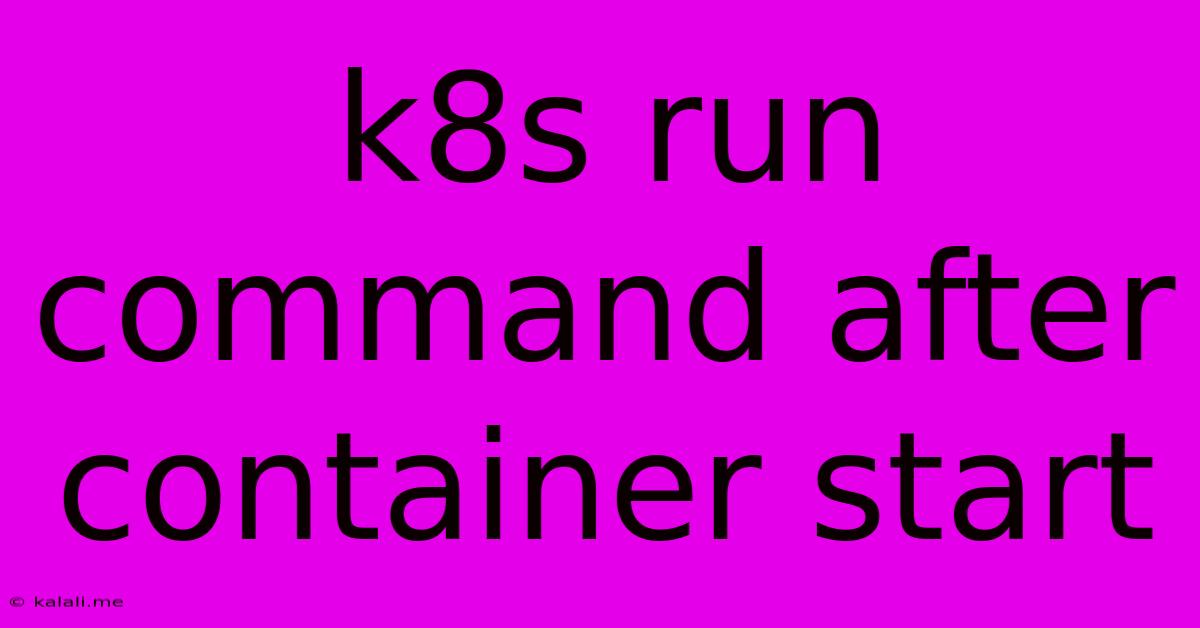K8s Run Command After Container Start
Kalali
Jun 07, 2025 · 3 min read

Table of Contents
Running Commands After Kubernetes Container Start: A Comprehensive Guide
This article explores various methods for executing commands within a Kubernetes container after the container has successfully started. This is a crucial aspect of container orchestration, enabling post-startup configurations, database migrations, and other essential tasks. We'll cover several approaches, ranging from simple to more sophisticated techniques, considering factors like efficiency and scalability. This guide is essential for Kubernetes administrators and developers seeking to optimize their containerized applications.
Understanding the Challenge
A common misconception is that simply including a command in your Dockerfile's CMD or ENTRYPOINT will suffice for post-startup actions. While this works for basic tasks, it doesn't handle situations requiring execution only after the application is fully initialized or dependent services are available. For complex scenarios, more robust solutions are necessary.
Methods for Executing Commands Post-Container Start
We'll examine several effective strategies, each with its own advantages and disadvantages:
1. Using Init Containers:
- Mechanism: Init containers run before application containers. They can perform tasks like database migrations, configuration setup, or health checks, ensuring the application container starts only after these prerequisite actions complete successfully.
- Advantages: Reliable, integrated into the Kubernetes workflow, and handles dependencies elegantly.
- Disadvantages: Adds complexity if not used appropriately. Overusing init containers can slow down the deployment process.
- Example: Define an init container that runs a script to populate a database before the main application container starts. The main container would only proceed after the init container completes successfully.
2. Kubernetes Jobs:
- Mechanism: Run a short-lived task that executes the required command. Jobs are ideal for one-off tasks or those not requiring persistent execution.
- Advantages: Simple to set up for isolated tasks, easy to manage and clean up after completion.
- Disadvantages: Not suitable for continuous, long-running processes. Requires careful monitoring and error handling.
- Example: Running a database migration script after the database container starts. The Kubernetes Job would monitor the database for readiness before executing the migration.
3. Sidecar Containers:
- Mechanism: Run a container alongside the main application container. The sidecar container can execute commands based on events or triggers from the main container.
- Advantages: Enables complex interactions and communication between containers. Provides a flexible approach to managing post-startup actions.
- Disadvantages: Introduces more resource consumption. Requires careful design to avoid resource contention.
- Example: A sidecar container monitoring the application logs and triggering a specific action if an error occurs. Or, running a process that regularly backs up data from the main application container.
4. Utilizing a Readiness Probe:
- Mechanism: Define a readiness probe in your application container. The probe checks if the application is ready to handle requests after completing initial setup. This can be combined with other methods for executing post-startup commands.
- Advantages: Ensures the application is truly ready before accepting traffic. Integrates seamlessly with Kubernetes health checks.
- Disadvantages: Requires careful implementation of the probe to accurately reflect the application's readiness state.
- Example: A readiness probe checks if a specific service is running or a configuration file is properly loaded before marking the container as ready.
5. Entrypoint Scripting (Advanced):
- Mechanism: Instead of a simple command in your
ENTRYPOINT, use a script that handles both application startup and post-startup actions. This script ensures a well-defined execution flow. - Advantages: Consolidates startup and post-startup logic in a single location.
- Disadvantages: Can increase complexity and require careful error handling within the script itself. This approach isn't as easily managed as the Kubernetes-native approaches.
- Example: A bash script handles starting the application and then performing database migrations or other necessary actions.
Choosing the Right Approach
The optimal method depends on the specific requirements of your application. For simple tasks, using an init container or a Kubernetes Job is generally sufficient. For more complex scenarios involving interactions between containers or intricate dependencies, sidecar containers or advanced entrypoint scripting might be more appropriate. Always consider resource utilization, scalability, and maintainability when making your selection. Remember to leverage Kubernetes features like readiness and liveness probes to ensure the health and reliability of your deployments.
Latest Posts
Latest Posts
-
Find Position From Velocity Time Graph
Jun 08, 2025
-
Shes Like A Dog Bone To Me Meaning
Jun 08, 2025
-
Folder Of An Image Layer In Gimp
Jun 08, 2025
Related Post
Thank you for visiting our website which covers about K8s Run Command After Container Start . We hope the information provided has been useful to you. Feel free to contact us if you have any questions or need further assistance. See you next time and don't miss to bookmark.